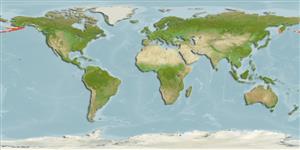>
Perciformes/Scorpaenoidei (Scorpionfishes) >
Sebastidae (Rockfishes, rockcods and thornyheads) > Sebastinae
Etymology: Sebastes: Greek, sebastes = august, venerable (Ref. 45335); ciliatus: Name from Latin 'ciliatus' meaning 'eyelash' (Ref. 27436) or 'eyelid', referring to the numerous accessory scales (similar to fringing eyelashes) on the psoterior field of the larger scales in most species of Sebastes (Ref. 53613).
Environment: milieu / climate zone / depth range / distribution range
Ecologie
marien demersaal; diepte 5 - 160 m (Ref. 53613). Temperate; 58°N - 50°N
North Pacific: western Aleutian Islands and eastern Bering Sea, through the Gulf of Alaska, to southeast Alaska; including south to Johnstone Strait, British Columbia.
Lengte bij maturiteit / Grootte / Gewicht / Leeftijd
Maturity: Lm 29.0 range ? - ? cm
Max length : 53.0 cm TL mannelijk / geslacht onbekend; (Ref. 27437); max. gepubliceerd gewicht: 1.8 kg (Ref. 40637); max. gerapporteerde leeftijd: 67 Jaren (Ref. 39247)
Korte beschrijving
Determinatiesleutels | Morfologie | Morfometrie
Dorsale stekels (totaal) : 13; Dorsale zachte stralen (totaal) : 15; Anale stekels: 3; Anale zachte stralen: 8. Head spines weak to very weak - nasals usually present, parietals usually absent, preocular, supraocular, postocular, tympanic, coronal and nuchal spines absent (Ref. 27437). Two distinct types, (1) dark dusky - uniformly dark or dusky in color, symphyseal knob absent and, (2) light dusky - a larger, greenish brown fish, lighter ventrally, fins tinged with pink or orange, symphyseal knob present (Ref. 27437). Caudal fin slightly indented (Ref. 6885).
Found hovering in loose organized groups just above rocky reefs and along shorelines, or may rest singly upon rocky substrate (Ref. 27436). Feed by picking and seizing food items that are either drifting or suspended in the water column (Ref. 27302). Viviparous (Ref. 34817). Sold as fresh or frozen fillets; eaten as fish cakes (Ref. 27436). Captured by the nearshore jig fishery and has been reported to comprise up to 25% of the catch in the 'black rockfish' jig fishery of the northern Gulf of Alaska (citation in Ref. 53613).
Eschmeyer, W.N., E.S. Herald and H. Hammann, 1983. A field guide to Pacific coast fishes of North America. Boston (MA, USA): Houghton Mifflin Company. xii+336 p. (Ref. 2850)
Status op de Rode Lijst van het IUCN (Ref. 130435)
Gevaar voor de mens
Harmless
Gebruik door de mens
Visserij: van minder commercieel belang; sportvis: ja
Tools
Speciale rapporten
Download XML
Internetbronnen
Estimates based on models
Preferred temperature (Ref.
123201): 1.2 - 5.8, mean 4.1 °C (based on 65 cells).
Fylogenetische diversiteitsindex (Ref.
82804): PD
50 = 0.5000 [Uniqueness, from 0.5 = low to 2.0 = high].
Bayesian length-weight: a=0.01000 (0.00499 - 0.02004), b=3.09 (2.92 - 3.26), in cm total length, based on LWR estimates for this Genus-body shape (Ref.
93245).
Trofisch niveau (Ref.
69278): 3.4 ±0.43 se; based on food items.
Weerstandsvermogen (Ref.
120179): Zeer laag, minimale populatieverdubbelingstijd meer dan 14 jaar (tmax=67).
Prior r = 0.24, 95% CL = 0.16 - 0.35, Based on 1 full stock assessment.
Fishing Vulnerability (Ref.
59153): Moderate vulnerability (41 of 100).
